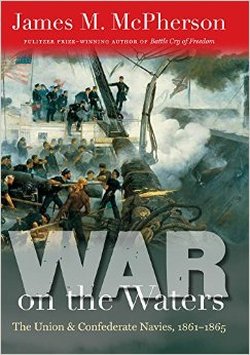
James M. McPherson
University of North Carolina Press, 2012, 278 pp. , $35.00
ISBN: 978-1-4696-2284-2
Image courtesy of amazon.com
There is no argument that the naval contributions to the American Civil War are largely ignored in the realm of Civil War academia. The few volumes which contribute to these discussions are often times narrowly focused and tend to feel constrained by their own subject matter. In James M. McPherson’s War on the Waters, that feeling is overcome by the complete treatment which the author gives his subject. In this one book, McPherson gives us a look into the world of both the Union and Confederate Navies which stands as work which fills in the gaps of many Civil War libraries.
James M. McPherson needs no introduction. He is the author of the great one volume work on the American Civil War Battle Cry of Freedom. He has also authored many other works including Tried by War, The Mighty Scourge, and What They Fought For, 1861-1865. He is the George Henry Davis ’86 Professor of History Emeritus at Princeton University and is one of the most respected names in the annals of Civil War academia. He is also the winner of the Pulitzer Prize and two Lincoln Prizes. This work, War on the Waters, is also part of the Littlefield History of the Civil War series being printed by the University of North Carolina Press.
There are a lot of things which I can say about this book, but one of the most important things which stood out to me as a reader was the even temperedness of the work. McPherson gives us a look into both the Union and Confederate Navies and explains their organizations and the government involvement in the departments. He gives a full blown narrative on the very thing Civil War students and readers have been asking for. Instead of bogging down the narrative with chapters on the minutia, he uses the events of the war to bring out the details which are so very important to a work such as this. Because of this, the narrative flows quite smoothly and he brings about the charm and reality in this work as he did with his ever popular Battle Cry of Freedom. Throughout the text, there are a great many maps and photographs which are placed to aid the reader and they are a welcome addition. These elements not only bring about a book which is accessible for Civil War students, it is a book which is accessible to the entire genre and should be welcomed as an addition to Battle Cry of Freedom.
I highly recommend this book to everyone interested in the American Civil War. Mr. McPherson has outdone himself this time by bringing this often overlooked subject into a more cohesive narrative. I feel as though the work and research placed in this book is top notch and should be used as an example for the ages to come. Most importantly, this book adds a great deal of depth to any library. Mr. McPherson should be praised for the work he has done here in his already exceptional career in Civil War writing.
 RSS Feed
RSS Feed
